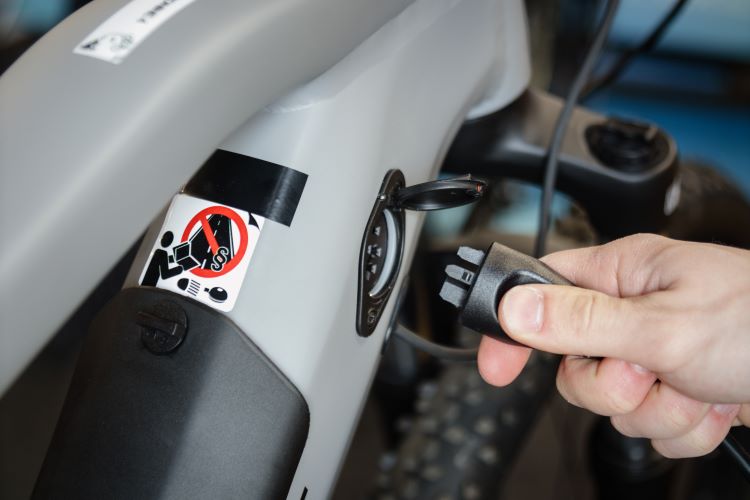Despite tabloid headlines about crashes and battery fires, in sensible hands an e-bike offers a safe, efficient and fun way to travel…
The huge boom in electric bike sales has inevitably led to a backlash, with newspaper headlines about e-bike crashes and battery fires skewing the positive narrative. There are of course risks associated with all forms of cycling. And precautions should be taken with any battery-powered gadget. That said, the best electric bikes remain a wonderfully safe and enjoyable way to travel, explore and exercise.
Are e-bikes dangerous to ride?
Although all forms of bike transport carry dangers, most e-bike riders feel safe when riding. It’s one of the reasons e-bikes are so popular. “A properly maintained electric bike bought from a reputable dealer is every bit as safe as a regular bike to ride,” explains Julian Scriven, Managing Director of Brompton Bike Hire.
“In fact, some would argue e-bikes are safer, as their additional power enables less confident cyclists to get ahead of traffic at traffic lights.” The power assistance can also minimise the drop in coordination, balance and mental focus that occurs when you get fatigued on a traditional bike.
E-bikes have the same brakes, pedals and handlebars as any other bike, so your safety and speeds are largely up to you. “An electric bike needs you to be pedalling for the motor to assist you. And that power assistance will stop as soon as you reach 15.5mph (25kph),” adds Scriven. So you’re not going to be riding at ridiculous speeds, even if you wanted to.

Some research does suggest there are more accidents involving e-bikes than other bikes. And according to the United States Consumer Product Safety Commission’s National Electronic Injury Surveillance System (NEISS), e-bike accident victims have a 17% risk of internal injury. That’s compared to 7.5% for riders of traditional bikes.
E-bike safety vs traditional bikes
But a study in the Journal of Transport & Health unpicked these apparently elevated risks, finding that most crashes involved less fit or more vulnerable or novice cycling populations, such as older cyclists with balance or coordination problems. Because e-bikes appeal to new or inexperienced riders, the number of crashes is inevitably higher. But that’s not to say that e-bikes themselves are unsafe. The study concluded that “e-bike users are not more likely to be involved in a crash or to sustain severe injuries”.

You can’t beat the Honbike Uni4 for regular low-mileage rides
BUY IT NOW:
($1,699 / £1,799), honbike.com
There are obvious risks new e-bike riders should avoid. For example, they may ride faster than they would on a normal bike, despite not being accustomed to higher speeds. E-bike riders also sometimes succumb to a false sense of security, with studies suggesting lower helmet use among e-bike riders than for regular bike riders. But these safety issues are down to rider behaviour, not e-bikes themselves.
So riders should be cautious when using e-bikes, not fearful of them. “Yes, e-bikes are safe, but wear all the necessary safety equipment, like a helmet, as you would with a regular bike,” insists Justin Stevenson, Head of Cycling Design at Halfords in the UK.
Are all e-bikes safe?
If you buy an e-bike from a reliable source, it’s likely to be safe and subject to robust safety standards. Where problems arise is on the black market for cheaper, faster or converted bikes. “Non-compliant electric motorbikes or mopeds are sometimes mis-sold online as fast e-bikes,” says Scriven. “There’s also a number of after-market conversion kits that can be fitted to regular bikes. In both cases, not only does this make the bike unsafe, but the rider faces steep fines and up to six penalty points if they hold a driving licence. In short, electric bikes are incredibly safe – uncertified illegal bikes are not.”
Should I be worried about battery fires?
Newspapers have reported several e-bike battery fires, but these are often linked to the purchase of an illegal bike or to a failure to follow instructions. “Legitimate electric bikes go through incredibly stringent testing and certification,” explains Scriven. “But a number of recent fires are believed to be linked to uncertified products being left unattended whilst charging.”
According to Stevenson, you can stay safe with these simple steps:
Never leave a charging e-bike unattended
“Always be alert and close by whenever you charge your e-bike battery. Never charge it while you’re asleep or away from home.”
Don’t overcharge the battery
“Only charge your e-bike battery as per the time recommended by your manufacturer. Overcharging can cause it to overheat.”
Don’t cover your battery
“Make sure nothing is covering the e-bike battery while it’s on charge, as this can lead to overheating.”
Charge your battery in a safe area
“Charge your e-bike indoors as cold temperatures can reduce the battery’s power capacity. However, make sure it’s done in a safe area.”
Store bikes and batteries in a cool place
“When you’re not using your e-bike, store it in a place where the temperature is not overly hot or cold. And it’s a good idea to ensure you have a smoke and heat detector installed.”
Unplug your charger
“Leaving an e-bike charger plugged in is a fire hazard, so get into the habit of unplugging. And don’t overload socket outlets.”
Related content:







